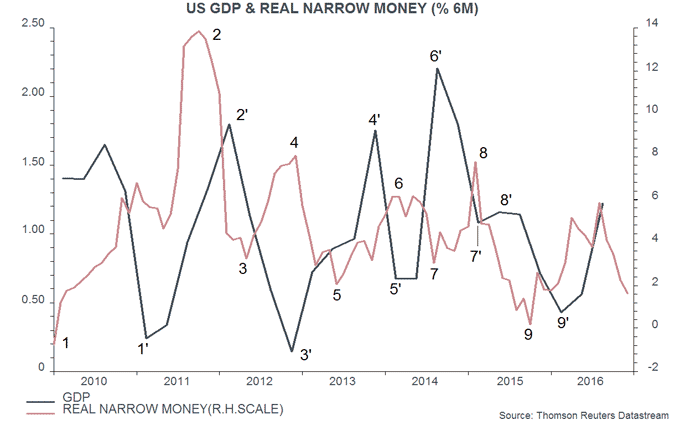US money trends at odds with consensus economic optimism
US narrow money trends weakened further in December, strengthening the conviction here that the economy will lose momentum from around spring 2017, in turn casting doubt on the average expectation of Federal Open Market Committee (FOMC) participants for a 75 basis point rise in official rates during 2017.
Swings in real (i.e. consumer price inflation-adjusted) narrow money growth have consistently led fluctuations in GDP expansion in recent years (and over the longer term) – see chart. Current economic strength reflects a surge in six-month real money growth to a peak in August 2016. The loss of monetary momentum since then echoes a sharp slowdown over the summer / autumn of 2015, which preceded weak GDP outcomes in winter 2015 / spring 2016. 
The final real money growth data point in the chart is a December estimate based on weekly monetary data through 26 December and an assumed 0.2% monthly rise in seasonally-adjusted consumer prices.
Monetary changes usually lead activity swings by between six and 12 months, with an average of nine months. The August 2016 peak in six-month real narrow money growth suggests that two-quarter GDP momentum will top out in the second quarter of 2017, plus or minus one quarter.
Any slowdown is expected here to be less pronounced than in late 2015 / early 2016 because 1) money trends are not as weak now as then and 2) the Kitchin stockbuilding cycle was entering a downswing phase in late 2015 but appears to have bottomed in 2016.
The obvious counter-argument to a slowdown forecast is that fiscal stimulus will boost growth in the second half of 2017 and 2018. The effects of fiscal policy, however, should be incorporated in narrow money trends: shifts in money demand are largely driven by changes in spending intentions of households and firms, which would strengthen in response to an effective fiscal stimulus. If the counter-argument is correct, that is, real money growth should rebound in early 2017. Even if it does, the recent pull-back suggests a softer patch for the economy around mid-2017.

Reader Comments